UnitedHealth Group Bundle
Can UnitedHealth Group Maintain Its Dominance in the Evolving Healthcare Market?
The healthcare industry is undergoing a seismic shift, and UnitedHealth Group is at the forefront of this transformation. With its strategic focus on integrated care models and technological innovation, the company is continuously reshaping the sector. Understanding the UnitedHealth Group SWOT Analysis is crucial to grasping its position.
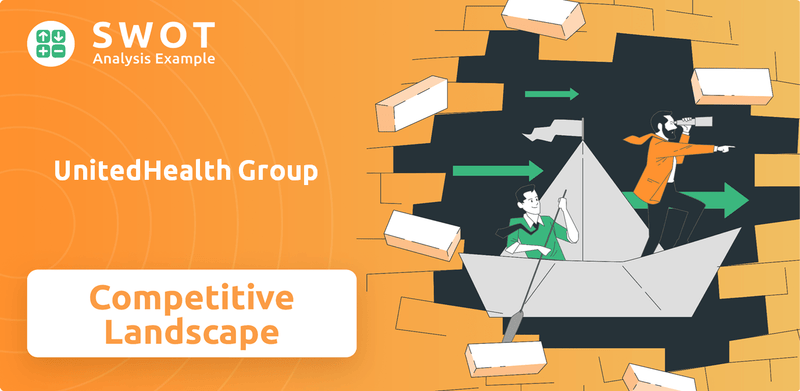
This exploration of UnitedHealth Group's competitive landscape delves into its market share, key competitors, and strategic advantages within the healthcare market analysis. We will examine its financial performance and growth strategy, providing insights into its ability to navigate the challenges and opportunities in the healthcare industry. A thorough competitor analysis will reveal the dynamics shaping UnitedHealth Group's future outlook and its impact on healthcare costs.
Where Does UnitedHealth Group’ Stand in the Current Market?
The market position of UnitedHealth Group (UHG) is exceptionally strong within the healthcare industry. As of early 2025, the company remains the largest healthcare entity by revenue. Its substantial market share and comprehensive service offerings are key indicators of its dominance. The company's strategic diversification and financial performance further solidify its leading position.
UHG's operations are segmented into two primary areas: UnitedHealthcare and Optum. UnitedHealthcare focuses on health benefits, serving approximately 53 million individuals. Optum provides information and technology-enabled health services, including pharmacy care, healthcare delivery, and data analytics. This dual approach allows UHG to cover a broad spectrum of healthcare needs, from insurance to direct healthcare services.
The company's financial health underscores its market leadership. UHG's 2024 revenues reached $371.6 billion, reflecting a year-over-year increase of 14.2%. This robust financial performance, alongside its substantial market capitalization, consistently places UHG among the top healthcare enterprises globally. The strategic expansion of Optum, particularly in value-based care and advanced analytics, further strengthens its market position.
UnitedHealth Group holds a significant market share in the healthcare industry, with its revenue reaching $371.6 billion in 2024. This substantial revenue reflects its strong market position and ability to capture a large portion of the healthcare market. The company's financial performance is a key indicator of its success in the competitive landscape.
The expansion of Optum has been a strategic move, enabling UHG to diversify beyond traditional health insurance. This diversification allows the company to offer a wider range of services, including pharmacy care, healthcare delivery, and data analytics. This integrated approach strengthens its position in the healthcare market and enhances its ability to serve various customer segments.
UHG operates through two main segments: UnitedHealthcare and Optum. UnitedHealthcare focuses on health benefits, serving a large number of individuals across the United States and internationally. Optum provides technology-enabled health services, which enhances UHG's comprehensive healthcare offerings and market reach.
UnitedHealth Group maintains a strong presence across most regions, with a particular focus on expanding Optum’s reach. This expansion includes strategic areas like value-based care and advanced analytics, which further strengthens its hold in high-growth healthcare sectors. Its broad geographic reach enhances its market position.
UnitedHealth Group's market position is bolstered by its financial strength, strategic diversification, and comprehensive service offerings. The company's ability to integrate health benefits with health services through Optum provides a significant competitive advantage. The company's focus on innovation and expansion into high-growth areas further strengthens its position in the healthcare market.
- Strong Financial Performance: Demonstrated by consistent revenue growth and profitability, as seen in the $371.6 billion revenue in 2024.
- Strategic Diversification: The expansion of Optum into health services and technology enhances its market reach.
- Comprehensive Service Offerings: Covering a wide range of healthcare needs, from insurance to direct healthcare services.
- Geographic Expansion: A strong presence across various regions, particularly in high-growth sectors.
To understand more about the financial aspects, you can explore the Revenue Streams & Business Model of UnitedHealth Group.
UnitedHealth Group SWOT Analysis
- Complete SWOT Breakdown
- Fully Customizable
- Editable in Excel & Word
- Professional Formatting
- Investor-Ready Format
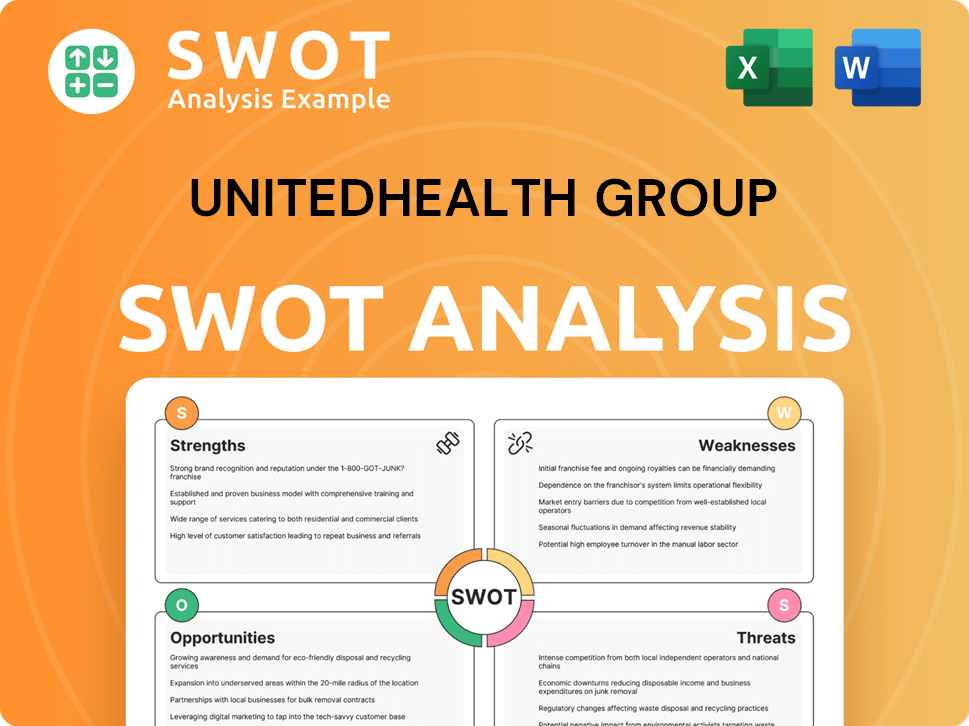
Who Are the Main Competitors Challenging UnitedHealth Group?
The Competitive landscape of UnitedHealth Group is shaped by a dynamic healthcare industry, encompassing both direct and indirect competitors across various business segments. This analysis is crucial for understanding UnitedHealth Group's market position 2024 and its strategic responses to evolving market dynamics. A thorough market analysis reveals the key players and their strategies, impacting UnitedHealth Group's financial performance and future growth.
UnitedHealth Group faces a complex competitive environment, necessitating continuous adaptation and innovation. Understanding the strategies of its rivals is vital for maintaining and enhancing its market share. This includes assessing their strengths, weaknesses, opportunities, and threats, which is essential for a comprehensive competitor analysis.
The healthcare market analysis reveals the competitive pressures faced by UnitedHealth Group. The company's ability to navigate these challenges directly influences its growth strategy and overall success. The competitive landscape is constantly changing due to mergers, acquisitions, and technological advancements.
UnitedHealth Group's primary competitors in the health insurance sector include Elevance Health, Aetna (a subsidiary of CVS Health), Cigna, and Humana. These companies compete across various segments, including employer-sponsored plans and government programs.
Elevance Health, formerly Anthem, is a significant competitor, particularly within the Blue Cross Blue Shield system. It competes directly with UnitedHealthcare for large employer accounts and government contracts. Elevance Health's broad range of health benefits products and services poses a direct challenge.
The integration of Aetna with CVS Health has created a formidable competitor. This partnership leverages a vast retail pharmacy and clinic network. This integrated approach challenges UnitedHealth Group's care delivery model.
Cigna focuses on employer-sponsored plans and its Evernorth health services segment. This positions Cigna as a direct competitor to both UnitedHealthcare and Optum, especially in pharmacy benefits management and care coordination.
Humana is a major player in the Medicare Advantage market, where it holds a substantial share. It often engages in fierce competition with UnitedHealthcare for senior enrollees. Humana's focus on Medicare Advantage is a key competitive factor.
UnitedHealth Group also competes with emerging players like telehealth providers and digital health platforms. These companies are disrupting traditional healthcare delivery models with innovative technology solutions. This includes companies like Teladoc Health and various startups.
The competitive landscape is shaped by pricing strategies, network breadth, and technological innovation. UnitedHealth Group's ability to offer integrated health solutions is crucial for success. The company's response to these challenges influences its future outlook.
- Pricing Strategies: Competitors constantly adjust pricing to attract customers.
- Network Breadth: The size and scope of provider networks are critical.
- Technological Innovation: Patient engagement and care delivery are enhanced through technology.
- Integrated Health Solutions: Offering comprehensive services improves outcomes and reduces costs.
- Mergers and Acquisitions: These activities reshape the competitive environment. For example, the CVS Health-Aetna merger.
For more insights into the company's origins and evolution, consider reading Brief History of UnitedHealth Group.
UnitedHealth Group PESTLE Analysis
- Covers All 6 PESTLE Categories
- No Research Needed – Save Hours of Work
- Built by Experts, Trusted by Consultants
- Instant Download, Ready to Use
- 100% Editable, Fully Customizable
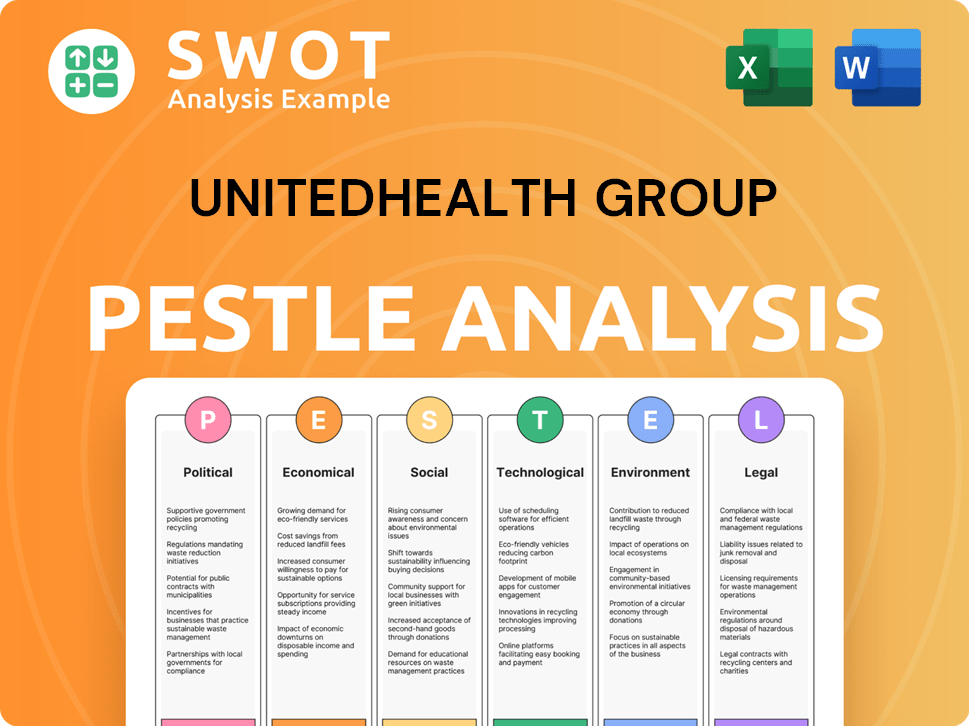
What Gives UnitedHealth Group a Competitive Edge Over Its Rivals?
Understanding the competitive landscape of UnitedHealth Group (UHG) requires a deep dive into its core strengths. The company's success is rooted in several key competitive advantages that have solidified its position in the healthcare market. These advantages have allowed it to maintain a leading role, even amidst significant industry changes and intense competition.
A primary strength of UnitedHealth Group is its comprehensive integration across the healthcare ecosystem. This integrated model allows for greater efficiency and improved care coordination. Its ability to leverage vast amounts of health data to drive better outcomes and reduce costs is a significant differentiator. The company's strategic moves, including acquisitions and technological advancements, have further enhanced its market position.
Another key advantage is its strong brand equity and extensive distribution networks. The brand is widely recognized and trusted, fostering significant customer loyalty among individuals, employers, and government entities. Its expansive network of healthcare providers and robust distribution channels ensure broad accessibility to its services, impacting the healthcare market analysis.
UnitedHealth Group's size and integrated structure are major competitive advantages. The company operates through two main segments: UnitedHealthcare, which provides health benefits, and Optum, which offers healthcare services and technology. This combination allows for greater efficiency and improved care coordination. In 2023, UnitedHealthcare served approximately 52.8 million people, demonstrating its vast reach.
Optum's capabilities in data analytics and technology provide a significant edge. These tools enable the company to develop sophisticated solutions for population health management, predictive modeling, and personalized care. UnitedHealth Group invests heavily in technology to improve its services and maintain a competitive edge. In 2023, Optum's revenue reached $224.7 billion, highlighting the importance of this segment.
The strong brand recognition and extensive distribution networks of UnitedHealth Group are critical. The UnitedHealthcare brand is widely trusted, fostering customer loyalty. Its expansive network of healthcare providers and robust distribution channels ensure broad accessibility to its services. This widespread reach supports its market share.
UnitedHealth Group's financial resources enable continuous investment in research and development, strategic acquisitions, and technological innovation. The company's ability to attract and retain top talent, particularly in data science, clinical care, and technology, also contributes to its competitive edge. This financial strength supports its long-term growth strategy.
UnitedHealth Group's competitive advantages are multifaceted, contributing to its leadership in the healthcare industry. These advantages include a strong brand, extensive distribution networks, and substantial financial resources for investment and innovation. The company’s integrated model and technological prowess set it apart from competitors, driving its success in the healthcare industry.
- Integrated Healthcare Model: Combines health benefits, healthcare delivery, and pharmacy care.
- Data Analytics: Leverages Optum's capabilities for population health management and predictive modeling.
- Financial Strength: Enables continuous investment in R&D and strategic acquisitions.
- Brand Recognition: The UnitedHealthcare brand fosters customer loyalty.
These advantages have evolved over time, with the company increasingly leveraging its data and technology to create more personalized and efficient healthcare solutions. For a deeper dive into how UnitedHealth Group approaches its market strategies, consider reading about the Growth Strategy of UnitedHealth Group. While these advantages are substantial, the company faces potential threats from rapid technological advancements and evolving regulatory pressures that could impact data utilization or market consolidation. Understanding these factors is crucial for a comprehensive healthcare market analysis.
UnitedHealth Group Business Model Canvas
- Complete 9-Block Business Model Canvas
- Effortlessly Communicate Your Business Strategy
- Investor-Ready BMC Format
- 100% Editable and Customizable
- Clear and Structured Layout
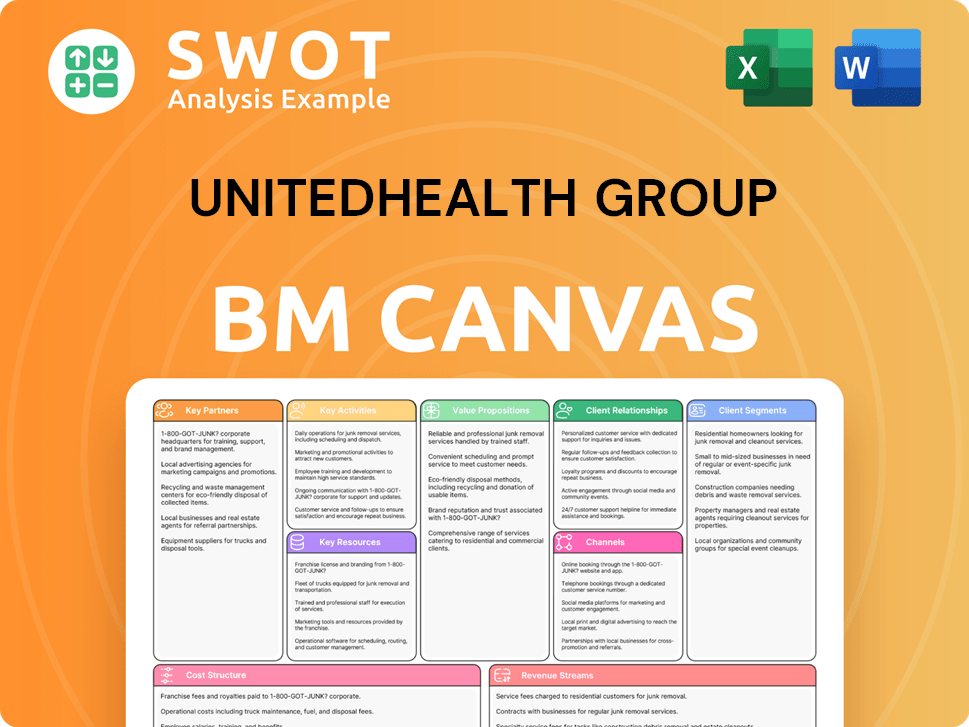
What Industry Trends Are Reshaping UnitedHealth Group’s Competitive Landscape?
The healthcare industry's competitive landscape is dynamic, with significant shifts impacting major players like UnitedHealth Group. This analysis provides a detailed look at the industry trends, future challenges, and opportunities shaping UnitedHealth Group's strategic positioning. Understanding the competitive forces is crucial for investors and stakeholders interested in the Target Market of UnitedHealth Group.
UnitedHealth Group faces a complex environment marked by both growth prospects and potential risks. Its ability to navigate these elements will determine its success in the coming years. This examination highlights key areas of focus, including technological advancements, regulatory changes, and evolving market dynamics.
The healthcare industry is seeing rapid adoption of digital health technologies, including telehealth and AI, creating opportunities for companies like UnitedHealth Group to improve care delivery. The shift towards value-based care models, which prioritize patient outcomes, is another significant trend. These changes necessitate innovative approaches to healthcare delivery and management.
Increased regulatory scrutiny on data privacy and security, particularly in digital health, poses compliance challenges. Rising healthcare costs and debates around healthcare reform continue to pressure insurers and providers. Potential competition from tech sector disruptors and economic downturns also present risks.
Opportunities lie in expanding into international markets and developing specialized digital health solutions. Strategic partnerships and acquisitions can further integrate care delivery. UnitedHealth Group can leverage its Optum segment to capitalize on these opportunities.
UnitedHealth Group's strategy involves continued investment in Optum's technological capabilities and a focus on value-based care. Strategic acquisitions further bolster its integrated healthcare ecosystem. These actions aim to maintain a competitive edge in the evolving market.
In 2024, the telehealth market is projected to continue its growth trajectory, with an estimated market size of over $60 billion. Value-based care models are expanding, with a projected 25% of healthcare payments in the US being tied to these models. Regulatory changes, such as those related to data privacy, are increasing compliance costs for healthcare providers.
- Market Share: UnitedHealth Group holds a significant market share in the health insurance sector.
- Financial Performance: The company's financial results, including revenue and earnings, reflect its strategic investments and market position.
- Competitive Advantages: UnitedHealth Group's integrated model, combining insurance and care delivery through Optum, provides a competitive edge.
- Future Outlook: The company's future outlook depends on its ability to adapt to industry trends and manage emerging challenges.
UnitedHealth Group Porter's Five Forces Analysis
- Covers All 5 Competitive Forces in Detail
- Structured for Consultants, Students, and Founders
- 100% Editable in Microsoft Word & Excel
- Instant Digital Download – Use Immediately
- Compatible with Mac & PC – Fully Unlocked
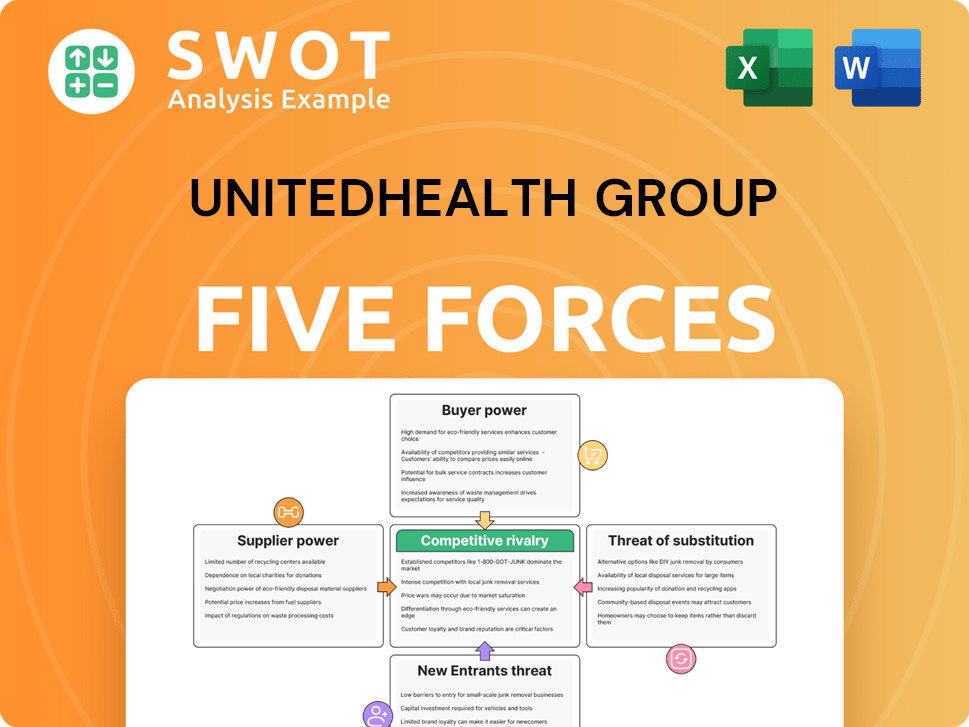
Related Blogs
- What are Mission Vision & Core Values of UnitedHealth Group Company?
- What is Growth Strategy and Future Prospects of UnitedHealth Group Company?
- How Does UnitedHealth Group Company Work?
- What is Sales and Marketing Strategy of UnitedHealth Group Company?
- What is Brief History of UnitedHealth Group Company?
- Who Owns UnitedHealth Group Company?
- What is Customer Demographics and Target Market of UnitedHealth Group Company?
Disclaimer
All information, articles, and product details provided on this website are for general informational and educational purposes only. We do not claim any ownership over, nor do we intend to infringe upon, any trademarks, copyrights, logos, brand names, or other intellectual property mentioned or depicted on this site. Such intellectual property remains the property of its respective owners, and any references here are made solely for identification or informational purposes, without implying any affiliation, endorsement, or partnership.
We make no representations or warranties, express or implied, regarding the accuracy, completeness, or suitability of any content or products presented. Nothing on this website should be construed as legal, tax, investment, financial, medical, or other professional advice. In addition, no part of this site—including articles or product references—constitutes a solicitation, recommendation, endorsement, advertisement, or offer to buy or sell any securities, franchises, or other financial instruments, particularly in jurisdictions where such activity would be unlawful.
All content is of a general nature and may not address the specific circumstances of any individual or entity. It is not a substitute for professional advice or services. Any actions you take based on the information provided here are strictly at your own risk. You accept full responsibility for any decisions or outcomes arising from your use of this website and agree to release us from any liability in connection with your use of, or reliance upon, the content or products found herein.